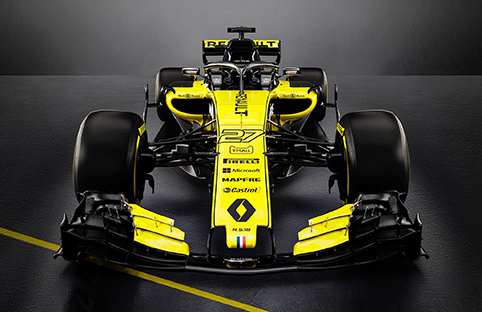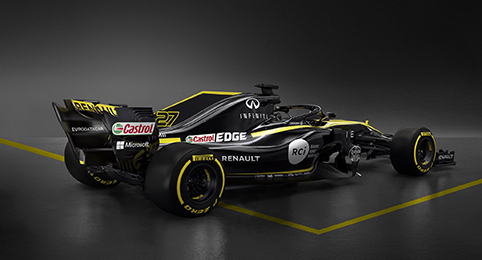This is the Renault R.S.18, sporting a revised livery that features more black than yellow.
The Enstore-built car will be driven by Nico Hulkenberg and Carlos Sainz, with the latter joining Renault in the last four races of the 2017 season.
Renault improved from ninth in the 2016 constructors’ championship to sixth in 2017, beating Toro Rosso at the Abu Dhabi Grand Prix.
The team’s development through 2017 was dramatic and it ended the campaign with the fourth-fastest car on merit, behind Mercedes, Ferrari and Red Bull.
Renault managing director Cyril Abiteboul wants to continue that upward trajectory this term.
“Last year was successful in many ways,” he said. “It was the second year in our rebuilding and a further step towards our long-term plans and aims.
“2016 was all about recruiting, investing, bringing in new sponsors, new talents and building our brand. It was a quantified progression towards what we want to become and challenging the top teams.
“Our headline target [for 2018] is to show continued progression through results. We want to be able to showcase our progression in every regard; power unit, chassis, operations, drivers.
“Everything must improve and we must continue to grow.
“We want to demonstrate this in many different ways, from the teams we will be directly racing against, to the gap to the leaders, including also our fan base and the respect that our team will inspire in our way we behave on and off track.”
Renault is the fifth team to reveal its 2018 design, after Haas, Williams, Red Bull and Sauber.
Liking the bold colours from Renault with the increase of black against the yellow. It does remind me of Jordan GP back in the days of Benson and Hedges sponsorship.
Best of luck to Renault in the upcoming Formula 1 season, challenging the other similar powered cars that is Red Bull and McLaren.



Social media:
https://twitter.com/RenaultSportF1/status/965964270297993217
https://twitter.com/RenaultSportF1/status/965966784204386305
https://twitter.com/RenaultSportF1/status/965971210088669184
Press release:
https://www.renaultsport.com/renault-sport-formula-one-team-devoile-sa-monoplace-2018.html?r=331
YouTube – 360° view of Renault R.S.18:
https://www.youtube.com/watch?v=sScTRKljFUs
News story:
https://www.formula1.com/en/latest/headlines/2018/2/renault-take-the-wraps-off-r-s-18-f1-car.html
https://www.racefans.net/2018/02/20/renaults-new-f1-car-2018-revealed/
http://www.skysports.com/f1/news/12433/11196676/renault-target-strides-up-f1-2018-grid-with-new-rs18-car
https://wtf1.com/post/renault-has-launched-its-2018-f1-contender/
Renault has appointed Jack Aitken to the role of third and reserve driver for the 2018 Formula 1 campaign.
Aitken, a member of the Renault Sport Academy, completed his second year in GP3 last season, finishing second overall behind ART Grand Prix teammate and Mercedes protege George Russell.
The pair will also race together in ART’s F2 outfit in 2018.
By graduating to F2 for 2018, Aitken, who drove a 2012 Lotus-built Renault F1 car last September as a reward for his 2017 GP3 campaign, is the highest-placed RSA member.
“Jack has been nurtured in the Renault Sport Academy so we’ve seen his development over the past couple of years,” said Renault managing director Cyril Abiteboul.
“It is clear he’s a talented young driver and he is ready for this opportunity. He has a full season ahead of him with racing in Formula 2 and fulfilling his Formula 1 commitments.
“He has the perfect environment to reach his targets and we are keen on seeing him in action.”
Last year’s F2 runner-up Artem Markelov, who continues in the series this year racing for Russian Time, has been named Renault F1 test and development driver.
The Russian will combine his fifth campaign at F2/GP2 level with simulator duties in Renault’s Enstone factory.
Source: Motorsport.com
Renault says “fresh approach” needed to sort reliability heading into the 2018 season. Motorsport.com has the details.
Renault believes that only a “fresh approach” to its work will deliver the reliability steps it needs to move forward in Formula 1 this year.
Although the team was encouraged last season by the progress it made with the speed of its car, as it often proved to be the fourth quickest team, it lost a number of good results through poor reliability.
That area has been a key point of attention for the team this winter and, speaking after the reveal of its new RS18, technical chief Bob Bell is clear that it needs to do things very differently this year to make things more robust.
“We need a strong reliability record,” said Bell. “That’s something we need to focus on, and we have worked hard on it over the winter. We need the car as reliable as we can make it.
“That’s a huge challenge, even more so than performance development, and it’s the toughest task we face.
“To improve reliability, we have to accept nothing less than perfection. Anything that ends up on the car needs to be designed and built to the highest standard; checked and rechecked as fit for purpose.
“All the issues which blighted us last year need to be eradicated by a fresh approach. It’s not something however that you can flick on like a switch, you need well established processes in place.”
Renault has already set a target of being a top three team in terms of mileage completed in pre-season testing – and it is something that Bell thinks is vital.
“We want a trouble-free winter test programme so we can validate the performance of the car and move forward,” he said. “To do this we need a reliable car and that’s one of the key goals for the Renault RS18.”
Renault’s hopes of a step forward should be boosted by encouraging news from its Viry test benches, where progress has been made in preparing for F1’s switch to three power units per year as it boasts having done more distance on the dyno than ever before.
The company’s F1 engine chief Remi Taffin said: “We did see our power unit on the top step of the podium three times last year, so it’s clear we have the potential to achieve our aspirations. We just need to raise our game across the board, and all the elements we need to do this are there.”
He added: “Our first priority is for reliability and it’s going to be even more difficult as we have to get another quarter out of the engine life on top of the target for 2017. Of course, we knew the three engine rule was going to come, so it’s something we scaled in for 2017 in preparation for 2018.
“We started designing the 2018 engine in 2016 with the three engine limitation in mind and we have completed more hours on the dyno than ever before.”